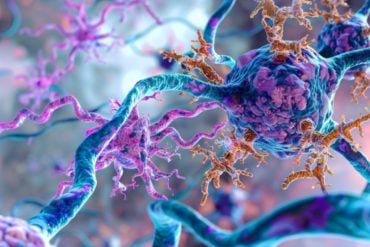Summary: Regulatory T cells interact with skin cells using glucocorticoid hormones to generate new hair follicles and promote hair growth. The findings could have positive implications for the development of new therapies to treat alopecia and other hair loss disorders.
Source: Salk Institute
Salk scientists have uncovered an unexpected molecular target of a common treatment for alopecia, a condition in which a person’s immune system attacks their own hair follicles, causing hair loss.
The findings, published in Nature Immunology on June 23, 2022, describe how immune cells called regulatory T cells interact with skin cells using a hormone as a messenger to generate new hair follicles and hair growth.
“For the longest time, regulatory T cells have been studied for how they decrease excessive immune reactions in autoimmune diseases,” says corresponding author Ye Zheng, associate professor in Salk’s NOMIS Center for Immunobiology and Microbial Pathogenesis.
“Now we’ve identified the upstream hormonal signal and downstream growth factor that actually promote hair growth and regeneration completely separate from suppressing immune response.”
The scientists didn’t begin by studying hair loss. They were interested in researching the roles of regulatory T cells and glucocorticoid hormones in autoimmune diseases. (Glucocorticoid hormones are cholesterol-derived steroid hormones produced by the adrenal gland and other tissues.) They first investigated how these immune components functioned in multiple sclerosis, Crohn’s disease and asthma.
They found that glucocorticoids and regulatory T cells did not function together to play a significant role in any of these conditions. So, they thought they’d have more luck looking at environments where regulatory T cells expressed particularly high levels of glucocorticoid receptors (which respond to glucocorticoid hormones), such as in skin tissue.
The scientists induced hair loss in normal mice and mice lacking glucocorticoid receptors in their regulatory T cells.
“After two weeks, we saw a noticeable difference between the mice—the normal mice grew back their hair, but the mice without glucocorticoid receptors barely could,” says first author Zhi Liu, a postdoctoral fellow in the Zheng lab.
“It was very striking, and it showed us the right direction for moving forward.”
The findings suggested that some sort of communication must be occurring between regulatory T cells and hair follicle stem cells to allow for hair regeneration.
Using a variety of techniques for monitoring multicellular communication, the scientists then investigated how the regulatory T cells and glucocorticoid receptors behaved in skin tissue samples.
They found that glucocorticoids instruct the regulatory T cells to activate hair follicle stem cells, which leads to hair growth. This crosstalk between the T cells and the stem cells depends on a mechanism whereby glucocorticoid receptors induce production of the protein TGF-beta3, all within the regulatory T cells.

TGF-beta3 then activates the hair follicle stem cells to differentiate into new hair follicles, promoting hair growth. Additional analysis confirmed that this pathway was completely independent of regulatory T cells’ ability to maintain immune balance.
However, regulatory T cells don’t normally produce TGF-beta3, as they did here. When the scientists scanned databases, they found that this phenomenon occurs in injured muscle and heart tissue, similar to how hair removal simulated a skin tissue injury in this study.
“In acute cases of alopecia, immune cells attack the skin tissue, causing hair loss. The usual remedy is to use glucocorticoids to inhibit the immune reaction in the skin, so they don’t keep attacking the hair follicles,” says Zheng. “Applying glucocorticoids has the double benefit of triggering the regulatory T cells in the skin to produce TGF-beta3, stimulating the activation of the hair follicle stem cells.”
This study revealed that regulatory T cells and glucocorticoid hormones are not just immunosuppressants but also have a regenerative function. Next, the scientists will look at other injury models and isolate regulatory T cells from injured tissues to monitor increased levels of TGF-beta3 and other growth factors.
Funding: This work was supported by a NOMIS fellowship and the NOMIS Foundation, the National Institute of Health (NCI CCSG P30-014195, NIA P01- 454 AG073084, NIA-NMG RF1-AG064049, NIA P30-AG068635, R01-AI107027, R01-AI1511123, R21-AI154919, and S10-OD023689), the Leona M. and Harry B. Helmsley Charitable Trust, the Crohn’s and Colitis Foundation, the National Cancer Institute, and Salk’s Cancer Center Core Facilities (P30-CA014195).
Other authors included Xianting Hu, Yuqiong Liang, Jingting Yu, and Maxim N. Shokhirev of Salk; and Huabin Li of Fudan University in Shanghai.
About this immune system and hair growth research news
Author: Press Office
Source: Salk Institute
Contact: Press Office – Salk Institute
Image: The image is in the public domain
Original Research: Closed access.
“Glucocorticoid signaling and regulatory T cells collaborate to maintain the hair follicle stem cell niche” by Ye Zheng et al. Nature Immunology
Abstract
Glucocorticoid signaling and regulatory T cells collaborate to maintain the hair follicle stem cell niche
Maintenance of tissue homeostasis is dependent on the communication between stem cells and supporting cells in the same niche. Regulatory T cells (Treg cells) are emerging as a critical component of the stem-cell niche for supporting their differentiation.
How Treg cells sense dynamic signals in this microenvironment and communicate with stem cells is mostly unknown. In the present study, by using hair follicles (HFs) to study Treg cell–stem cell crosstalk, we show an unrecognized function of the steroid hormone glucocorticoid in instructing skin-resident Treg cells to facilitate HF stem-cell (HFSC) activation and HF regeneration.
Ablation of the glucocorticoid receptor (GR) in Treg cells blocks hair regeneration without affecting immune homeostasis. Mechanistically, GR and Foxp3 cooperate in Treg cells to induce transforming growth factor β3 (TGF-β3), which activates Smad2/3 in HFSCs and facilitates HFSC proliferation.
The present study identifies crosstalk between Treg cells and HFSCs mediated by the GR–TGF-β3 axis, highlighting a possible means of manipulating Treg cells to support tissue regeneration.







